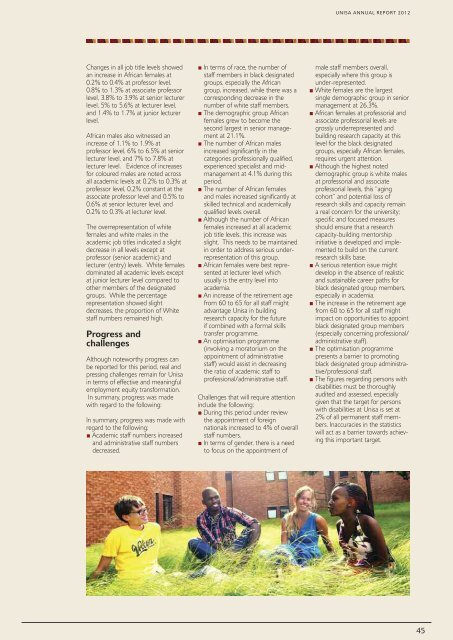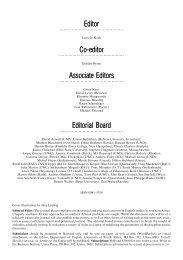ANNUAL REPORT 2012 - University of South Africa
ANNUAL REPORT 2012 - University of South Africa
ANNUAL REPORT 2012 - University of South Africa
Create successful ePaper yourself
Turn your PDF publications into a flip-book with our unique Google optimized e-Paper software.
UNISA <strong>ANNUAL</strong> <strong>REPORT</strong> <strong>2012</strong><br />
Changes in all job title levels showed<br />
an increase in <strong>Africa</strong>n females at<br />
0.2% to 0.4% at pr<strong>of</strong>essor level,<br />
0.8% to 1.3% at associate pr<strong>of</strong>essor<br />
level, 3.8% to 3.9% at senior lecturer<br />
level, 5% to 5.6% at lecturer level,<br />
and 1.4% to 1.7% at junior lecturer<br />
level.<br />
<strong>Africa</strong>n males also witnessed an<br />
increase <strong>of</strong> 1.1% to 1.9% at<br />
pr<strong>of</strong>essor level, 6% to 6.5% at senior<br />
lecturer level, and 7% to 7.8% at<br />
lecturer level. Evidence <strong>of</strong> increases<br />
for coloured males are noted across<br />
all academic levels at 0.2% to 0.3% at<br />
pr<strong>of</strong>essor level, 0.2% constant at the<br />
associate pr<strong>of</strong>essor level and 0.5% to<br />
0.6% at senior lecturer level, and<br />
0.2% to 0.3% at lecturer level.<br />
The overrepresentation <strong>of</strong> white<br />
females and white males in the<br />
academic job titles indicated a slight<br />
decrease in all levels except at<br />
pr<strong>of</strong>essor (senior academic) and<br />
lecturer (entry) levels. White females<br />
dominated all academic levels except<br />
at junior lecturer level compared to<br />
other members <strong>of</strong> the designated<br />
groups. While the percentage<br />
representation showed slight<br />
decreases, the proportion <strong>of</strong> White<br />
staff numbers remained high.<br />
Progress and<br />
challenges<br />
Although noteworthy progress can<br />
be reported for this period, real and<br />
pressing challenges remain for Unisa<br />
in terms <strong>of</strong> effective and meaningful<br />
employment equity transformation.<br />
In summary, progress was made<br />
with regard to the following:<br />
In summary, progress was made with<br />
regard to the following:<br />
n Academic staff numbers increased<br />
and administrative staff numbers<br />
decreased.<br />
n In terms <strong>of</strong> race, the number <strong>of</strong><br />
staff members in black designated<br />
groups, especially the <strong>Africa</strong>n<br />
group, increased, while there was a<br />
corresponding decrease in the<br />
number <strong>of</strong> white staff members.<br />
n The demographic group <strong>Africa</strong>n<br />
females grew to become the<br />
second largest in senior management<br />
at 21.1%.<br />
n The number <strong>of</strong> <strong>Africa</strong>n males<br />
increased significantly in the<br />
categories pr<strong>of</strong>essionally qualified,<br />
experienced specialist and midmanagement<br />
at 4.1% during this<br />
period.<br />
n The number <strong>of</strong> <strong>Africa</strong>n females<br />
and males increased significantly at<br />
skilled technical and academically<br />
qualified levels overall.<br />
n Although the number <strong>of</strong> <strong>Africa</strong>n<br />
females increased at all academic<br />
job title levels, this increase was<br />
slight. This needs to be maintained<br />
in order to address serious underrepresentation<br />
<strong>of</strong> this group.<br />
n <strong>Africa</strong>n females were best represented<br />
at lecturer level which<br />
usually is the entry level into<br />
academia.<br />
n An increase <strong>of</strong> the retirement age<br />
from 60 to 65 for all staff might<br />
advantage Unisa in building<br />
research capacity for the future<br />
if combined with a formal skills<br />
transfer programme.<br />
n An optimisation programme<br />
(involving a moratorium on the<br />
appointment <strong>of</strong> administrative<br />
staff) would assist in decreasing<br />
the ratio <strong>of</strong> academic staff to<br />
pr<strong>of</strong>essional/administrative staff.<br />
Challenges that will require attention<br />
include the following:<br />
n During this period under review<br />
the appointment <strong>of</strong> foreign<br />
nationals increased to 4% <strong>of</strong> overall<br />
staff numbers.<br />
n In terms <strong>of</strong> gender, there is a need<br />
to focus on the appointment <strong>of</strong><br />
male staff members overall,<br />
especially where this group is<br />
under-represented.<br />
n White females are the largest<br />
single demographic group in senior<br />
management at 26.3%.<br />
n <strong>Africa</strong>n females at pr<strong>of</strong>essorial and<br />
associate pr<strong>of</strong>essorial levels are<br />
grossly underrepresented and<br />
building research capacity at this<br />
level for the black designated<br />
groups, especially <strong>Africa</strong>n females,<br />
requires urgent attention.<br />
n Although the highest noted<br />
demographic group is white males<br />
at pr<strong>of</strong>essorial and associate<br />
pr<strong>of</strong>essorial levels, this “aging<br />
cohort” and potential loss <strong>of</strong><br />
research skills and capacity remain<br />
a real concern for the university;<br />
specific and focused measures<br />
should ensure that a research<br />
capacity-building mentorship<br />
initiative is developed and implemented<br />
to build on the current<br />
research skills base.<br />
n A serious retention issue might<br />
develop in the absence <strong>of</strong> realistic<br />
and sustainable career paths for<br />
black designated group members,<br />
especially in academia.<br />
n The increase in the retirement age<br />
from 60 to 65 for all staff might<br />
impact on opportunities to appoint<br />
black designated group members<br />
(especially concerning pr<strong>of</strong>essional/<br />
administrative staff).<br />
n The optimisation programme<br />
presents a barrier to promoting<br />
black designated group administrative/pr<strong>of</strong>essional<br />
staff.<br />
n The figures regarding persons with<br />
disabilities must be thoroughly<br />
audited and assessed, especially<br />
given that the target for persons<br />
with disabilities at Unisa is set at<br />
2% <strong>of</strong> all permanent staff members.<br />
Inaccuracies in the statistics<br />
will act as a barrier towards achieving<br />
this important target.<br />
45
















